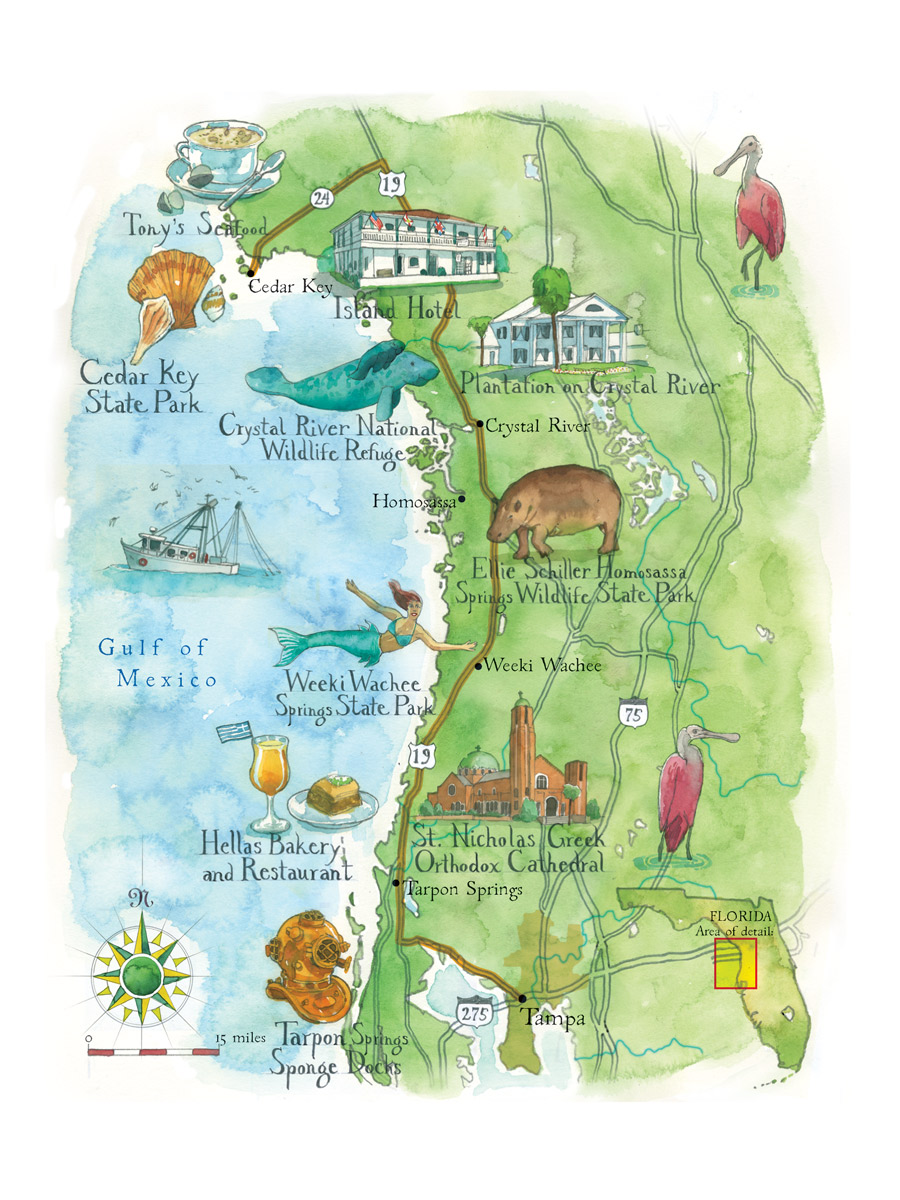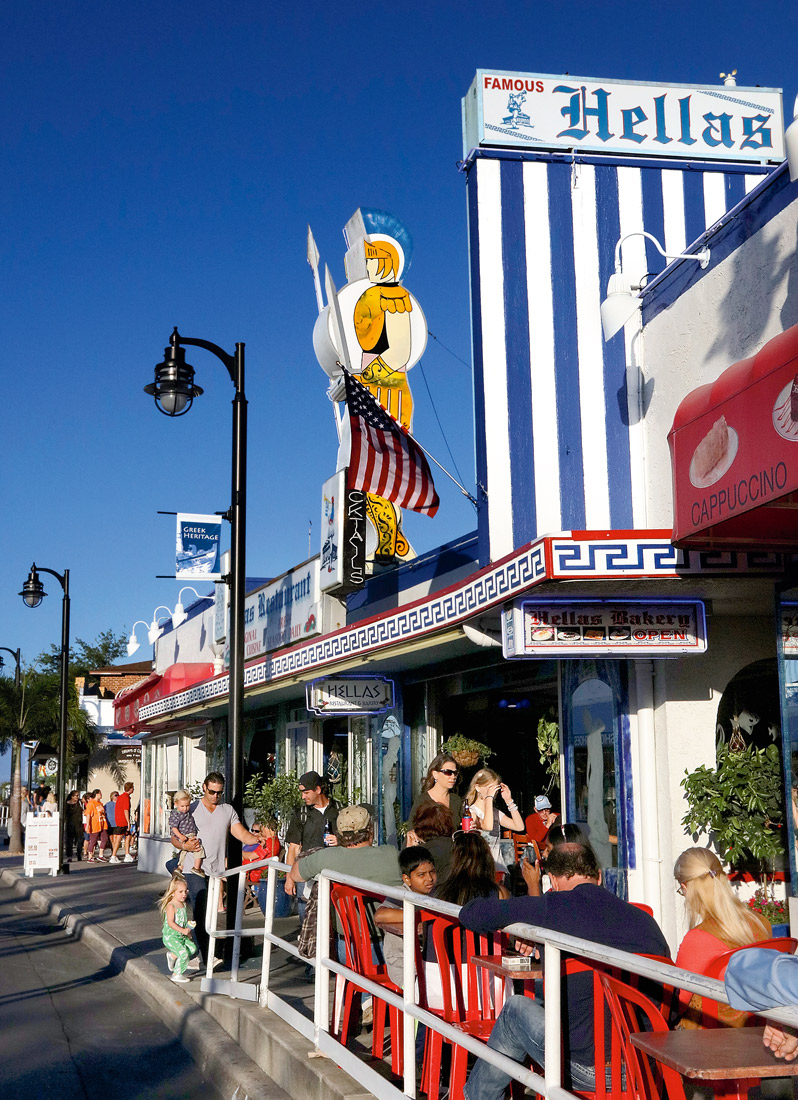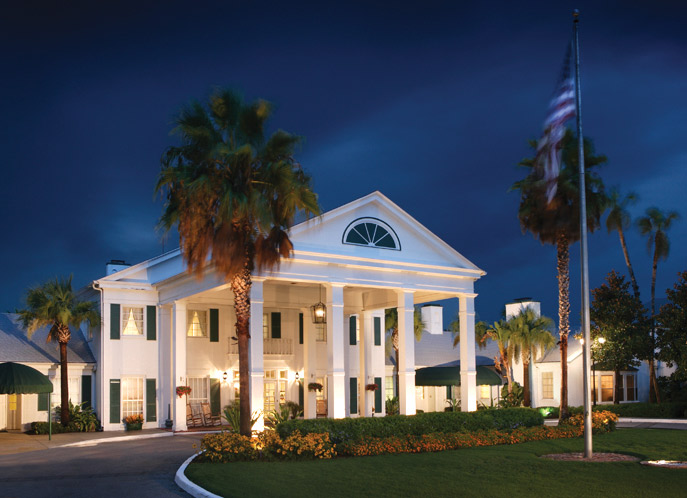
Illustrated map by Steven Stankiewicz
For decades, recreational boaters referred to west central Florida as the “lonesome leg.” That’s because on their 160-mile trips from Clearwater to the Big Bend (where the panhandle meets the peninsula) they never encountered a single buoy. Today, the area is known as Florida’s Nature Coast, and it attracts adventurers eager to explore its renowned wildlife parks and nature preserves, crystal-clear springs and blackwater rivers. But this part of Florida, a magic kingdom of the truest sort, also offers travelers along U.S. Highway 19 an unexpected excursion: a journey back in time.
In Tarpon Springs, step back to the turn of the twentieth century, when the town’s sponge industry boomed and hundreds of Greek divers arrived to bring up the bounty. Up the road in Weeki Wachee and Homosassa, as Publix-anchored strip malls give way to forests of pine, palmetto, and oak, you’ll find the golden age of the American road trip lives on at midcentury roadside attractions showcasing mermaids, underwater observatories, and a hippopotamus named Lu. Hang a left in Otter Creek and follow State Road 24 back to nineteenth-century Florida and the sleepy fishing village and artists enclave of Cedar Key.

Photograph courtesy of visitstpeteclearwater.com
Tarpon Springs Sponge Docks
In 1873, rich sponge beds were discovered at the mouth of the Anclote River, and by the turn of the century, nearby Tarpon Springs was the largest sponge port in the nation. The first of some 500 Greek divers arrived in 1905 to expand the sponge operation into deeper waters. So successful were these immigrants, sponging soon became Florida’s largest industry. Visitors to the historic docks and the former sponge exchange can shop for a range of varieties—both decorative and utilitarian—including yellow, finger, wire, vase, and wool. St. Nicholas Boat Lines, established in 1924, offers short river cruises aboard historic sponge-diving vessels and demonstrations of sponge harvesting by a diver in traditional gear.

Photograph courtesy of visitstpeteclearwater.com
Hellas Bakery & Restaurant
Thousands of Greek immigrants followed the divers to Tarpon Springs, opening grocery stores, sweets shops, and restaurants. Today, the town has the highest percentage of Greek-American residents of any city in the nation and is a must-visit destination for Greek cuisine. Snag a table at always-bustling Hellas, founded in 1970, for favorites such as gyros, moussaka, pastitsio, and dolmades served in a kitschy dining room bathed in blue neon and lined with colorful murals of Greek village life. Indulge in Greek takes on martinis, mojitos, and sangria featuring ouzo and pomegranate liqueur. After dinner, step into the adjoining bakery for a classic Greek dessert—baklava, galaktoboureko (custard pie), or kourabiedes (butter cookies)—and a wonderfully bitter cup of Greek coffee.

Dawna Moore/Alamy Stock Photo
St. Nicholas Greek Orthodox Cathedral
In Tarpon Springs, community life centers on this impressive neo-Byzantine structure inspired by the Hagia Sophia and rendered in yellow brick. Completed in 1943, the cathedral houses a number of treasures: crystal chandeliers imported from Czechoslovakia and an altar, Bishop’s throne, and choir stalls carved from marble donated by the Greek government (the stone was originally used for the nation’s pavilion at the 1939 World’s Fair). The cathedral also displays scores of hand-painted icons; best known is the Weeping Icon of St. Nicholas, which draws pilgrims from around the world hoping to witness the miraculous formation of crystal-like drops around his eyes, first spotted in 1970.

Photograph courtesy of Weeki Wachee Springs State Park
Weeki Wachee Springs State Park
Since 1947, the 74.2-degree waters of one of the world’s deepest natural springs have served as the playground of mermaids. During Weeki Wachee Springs’ heyday in the 1950s and ’60s, it was among the most popular tourist attractions in the nation, thrilling crowds with underwater productions of Peter Pan and The Wizard of Oz. Today, visitors still pack the 400-seat indoor Mermaid Theater submerged sixteen feet below the water’s surface to watch accomplished swimmers clad in Lycra tails feed fish, drink bottled Cokes, eat apples, and perform synchronized underwater acrobatics to the beat of sock-hop standards and the ethereal strains of Enya.

Photograph courtesy of Ellie Schiller Homosassa Springs State Park
Ellie Schiller Homosassa Springs Wildlife State Park
This park traces its beginnings to the early 1900s, when trains on the so-called “Mullet Express” stopped to allow passengers to take in the springs and view the native wildlife. In the 1940s, a small underwater observatory and zoo were established at the main spring, and in 1964, the park was expanded and rebranded “Nature’s Own Attraction.” The big draws were a markedly larger observatory known as the Fish Bowl and a host of trained exotic animals who resided at the park when they weren’t appearing on TV shows or working on movie sets. (These included the bear who played Gentle Ben and Judy the Chimpanzee, who appeared in a host of shows, from Lost in Space to The Beverly Hillbillies.) After the state acquired the park in 1988, the focus turned to native species, and today visitors will encounter West Indian manatees, Florida panthers, black bears, Key deer, and alligators, as well as a host of birds. Be sure to pay a visit to Lucifer “Lu” the hippo; the beloved longtime resident was granted state citizenship by former Governor Lawton Chiles so he could remain in the park he’s called home for fifty-four years. At fifty-eight, he’s the oldest hippo in North America.

Photograph courtesy of Plantation on Crystal River
Plantation on Crystal River
For more than half a century, this 232-acre eco-friendly resort in the town of Crystal River has served as the jumping-off point for outdoor adventures on Florida’s Nature Coast. Guests of the 196-room hotel can rent canoes, kayaks, and pontoon boats or book fishing charters at the Plantation Adventure Center and explore the surrounding labyrinth of lakes and rivers. The center is also one of the few operators that offers visitors the unforgettable opportunity to snorkel alongside West Indian manatees in Crystal River, the only place in the world where one can swim with the endangered species. After a day in the wilds of West Florida, feast on locally sourced dishes such as pan-roasted grouper and seafood pasta featuring Florida spiny lobster tail, Gulf shrimp, and sea scallops at the resort’s West 82° Grill.

Photograph courtesy of Plantation on Crystal River
Crystal River National Wildlife Refuge
Between November and March, some 600 manatees gather at this refuge, whose spring-fed waters stay seventy-two degrees year-round. While many visitors view the gentle giants from boats or on snorkeling tours, those who wish to remain on land are afforded excellent opportunities to experience this annual homecoming from the Three Sisters Boardwalk. The refuge also operates an on-site visitors center featuring manatee exhibits and offers interpretative talks at the boardwalk throughout the winter.
Island Hotel
Sloping wood floors, well-worn furnishings, and slowly turning ceiling fans welcome guests to the 1859 building that has served as the home of this Cedar Key inn since 1946. Early patrons flocked for seafood dinners in the dining room and overnighted in the hotel’s cozy, simply furnished guest rooms; among them were author Pearl Buck, entertainer Tennessee Ernie Ford, and a host of Florida politicos. Plan to spend an evening over beer and burgers in the hotel’s wood-paneled Neptune Bar. Anchored by a 1948 portrait of the Roman god of the sea, the popular watering hole was the site of many an impromptu Jimmy Buffett concert in the 1980s.

James Quine/Alamy Stock Photo
Tony’s Seafood Restaurant
Patrons pack the tiny dining room of this Cedar Key restaurant for steaming bowls of clam chowder, which took the top prize at three consecutive Great Chowder Cook-offs. (The organizers of the Newport, Rhode Island–based national competition inducted Tony’s into the Great Chowder Hall of Fame in 2011 and retired the recipe from the contest.) Try snagging a table by the window for a front-row seat of the always-interesting cast of characters—artists, motorcyclists, dogs—cavorting on 2nd Street, the town’s main strip. And be sure to pick up a few cans—or a case—of the creamy, kicky chowder to take home.
Cedar Key Museum State Park
Drop by this small state park to learn about the rich history of Cedar Key, which served as a railroad center and shipping port in the nineteenth century, transporting seafood and timber to markets across the eastern United States. Some displays tell the story of the area’s once-booming pencil industry, which relied on locally harvested cedar and graphite imported from Siberia. A park highlight is the former home of St. Clair Whitman, a Cedar Key resident who turned a room in his circa-1880 house into the island’s first museum in the 1940s. Visitors are afforded a glimpse of life as it once was in rural Florida, as well as the chance to view Whitman’s impressive collections of seashells and American Indian artifacts.
This article appears in our Fall/Winter 2018 issue of Southbound.












